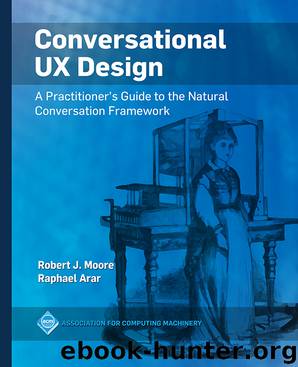Conversational UX Design: A Practitioner’s Guide to the Natural Conversation Framework by Robert J. Moore and Raphael Arar

Author:Robert J. Moore and Raphael Arar
Language: eng
Format: epub
Publisher: Association for Computing Machinery
B2.2 Partial Repeat Request
While the repeat request typically elicits a full repeat of the prior agent utterance, the partial repeat request elicits only a part of it (Pattern B2.2.0, Example 6.10).
Pattern B2.2.0Partial Repeat Request.
1 A:<ANY UTTERANCE>
2 U:PARTIAL REPEAT + what/who/when/where/why
3 A:PARTIAL REPEAT
Example 6.10Partial Repeat Request.
1 A:I guess I like movies with a strong AI lead.
2 U:a strong what?
3 A:AI lead.
With the partial repeat request, the user repeats a part of the agent’s prior utterance, “a strong” followed by a question word, “what” (line 2). By recycling part of the prior utterance, the user can demonstrate what he or she heard, and the question word indicates a failure at least to hear whatever words came after that [Schegloff 2007, pp. 217–218]. In our implementation, the dialog detects the question word at the end of the user’s input, extracts what came before it, matches the sample to the value of repeat of the agent’s utterance, and displays the remaining words back to the user, “AI lead” (line 3). This practice is very efficient, especially in voice interactions, in eliciting a repeat of just the part of the prior utterance that the recipient did not hear, instead of repeating the whole thing.
Download
This site does not store any files on its server. We only index and link to content provided by other sites. Please contact the content providers to delete copyright contents if any and email us, we'll remove relevant links or contents immediately.
Algorithms of the Intelligent Web by Haralambos Marmanis;Dmitry Babenko(8529)
Test-Driven Development with Java by Alan Mellor(7443)
Data Augmentation with Python by Duc Haba(7332)
Principles of Data Fabric by Sonia Mezzetta(7078)
Learn Blender Simulations the Right Way by Stephen Pearson(7022)
Microservices with Spring Boot 3 and Spring Cloud by Magnus Larsson(6837)
RPA Solution Architect's Handbook by Sachin Sahgal(6252)
Hadoop in Practice by Alex Holmes(6039)
The Infinite Retina by Robert Scoble Irena Cronin(5954)
Jquery UI in Action : Master the concepts Of Jquery UI: A Step By Step Approach by ANMOL GOYAL(5878)
Big Data Analysis with Python by Ivan Marin(5744)
Life 3.0: Being Human in the Age of Artificial Intelligence by Tegmark Max(5410)
Pretrain Vision and Large Language Models in Python by Emily Webber(4702)
Infrastructure as Code for Beginners by Russ McKendrick(4484)
WordPress Plugin Development Cookbook by Yannick Lefebvre(4214)
Functional Programming in JavaScript by Mantyla Dan(4129)
The Age of Surveillance Capitalism by Shoshana Zuboff(4126)
Embracing Microservices Design by Ovais Mehboob Ahmed Khan Nabil Siddiqui and Timothy Oleson(4005)
Applied Machine Learning for Healthcare and Life Sciences Using AWS by Ujjwal Ratan(3981)
